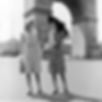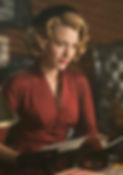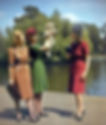War and fashion
- Katerina
- 4 мая 2021 г.
- 5 мин. чтения
Обновлено: 7 сент. 2023 г.
In a few days, we will celebrate the 76th Victory Day.
During the Second World War, fashion was not a priority, but it did not die. Clothing absorbed the spirit of the time, became less elegant and more practical.

Buying clothes has become difficult. Almost all enterprises of the clothing and textile industries carried out military orders and did not produce ordinary clothes. In all countries participating in the war, were strict regulations on the purchase of clothing and fabrics. They were given out on cards or coupons.

Women had to create or remake things that were supposed to last a long time. Women learned to be frugal and inventive, learned to embroider and knit.
Fashion magazines used to advertise new dresses, but now they announced that fashion was out of fashion, and promoted wearing one dress for different occasions, while helping the outfit to look a little different with the help of accessories, repairing them as needed. In addition to clothing, fashion magazines featured columns on gardening and canning food for the winter.

Fabrics were practically inaccessible. It was forbidden to use silk, wool and nylon for civilian purposes. Only used parachutes made it possible to sew from silk. Clothing made from the parachute of a downed enemy pilot was considered especially chic.

Silk was used for wedding and evening dresses. They were long, tight around the hips and widened at the bottom, often with bare shoulders. Mostly evening dresses were sewn from tulle, using curtains for this.
During the war years, women were left without nylon stockings. They had to draw a strip on their bare legs, imitating the seam of a stocking. This service was provided by some shoe stores.
Due to the shortage of stockings, trousers have become entrenched in the women's wardrobe. They were worn not only on vacation, as before, but also in everyday life, especially by working women. The trousers were sewn wide and practical.

The costumes of that era resembled a strict military uniform: simple styles, often fitted, always with shoulder pads. The dark colors of the military uniform prevailed: shades of green and blue. Due to the inability to get the same buttons, women covered buttons with similar shapes with fabric.
Skirts became narrower and shorter. Practical length - to the knee or just below the knee.
Dresses and blouses were decorated with collars, which made them more solemn.

Designers showed patriotism and used military elements in the decoration of women's civilian clothing: voluminous pockets, belts, buckles, epaulettes, ties. This created a feeling of unity between the army and the people.

Women began to carry bags over their shoulders. They were much more comfortable than the old handbags, left hands free. The prototypes of such bags were a military tablet, a postman's bag and a gas mask bag.
In 1939, Coco Chanel and Madeleine Vionnet closed their fashion houses in Paris. Almost until the middle of 1940, the extravagant fashion house of Elsa Schiaparelli continued to operate. She changed the format, and began to create collections with a military theme. In collaboration with Robert Piguet, Elsa created jumpsuits for bomb shelters.
The jumpsuit became a very popular piece of clothing during the war. It was comfortable as it could be put on quickly. Jumpsuits were sewn from dense fabrics, they were warm and had many pockets in which everything you needed could be folded in a matter of seconds.

When it became impossible to continue working, Elsa went to the USA on a promotional tour to promote French fashion and culture. She took only one collection with her and did not create new collections until 1945.
Meanwhile, American fashion began to develop. Claire McCardell became the founder of democratic American fashion. She sewed light and comfortable wrap dresses for everyday wear. In such dresses, it was convenient for women to do housework and at the same time look attractive.

Shoe leather was used only at the front, so the popularity of fabric shoes grew. Also flat shoes and models with open toes or heels were fashionable.
In the shoe industry, the most popular designer was the Italian Salvatore Ferragamo. He created futuristic models of shoes from cellophane, straw, hemp, cork. Salvatore created the America wedge-heeled shoes from nylon mesh, for which he received the Neiman Marcus Award.

During the war years, hats were often worn. They hid the flaws of the hairstyle. In addition to felt hats, women were very fond of turbans. They were made from a wide variety of fabrics, shawls and scarves.
Occupational safety required that the head be tied, so the turban became an integral part of the female wartime image.
I saw this 1940s ensemble of a Georgian style coat with hand-embroidery and a hat imitating a turban, in September 2019 at the “VDNH in Fashion” exhibition from the Alexander Vasiliev Foundation at VDNKh, in Moscow.

The fabric saving mode also affected the beach fashion. Before the war, women wore one-piece swimsuits with a short skirt. Now there were two-piece swimsuits with high-waisted briefs. These were the first steps towards the introduction of the bikini in 1946.

Sportswear, shorts, open belly became popular.

There were no fashion shows in Europe, but American films were shown. Therefore, during the war, American Hollywood becomes a fashion trendsetter.
Fashion trends were dictated by film stars: Lana Turner, Veronica Lake, Lauren Bacall, Marlene Dietrich, Ava Gardner, Rita Hayworth, Betty Grable, Katharine Hepburn, Hedy Lamar, Ingrid Bergman.
In contrast to actresses with a restrained style, Brazilian actress and singer Carmen Miranda became popular in the United States at the same time. In her colorful stage image there were many beads, bracelets and hats with flowers and fruits. She loved long skirts and platform shoes.
I suggest watching my favorite performance by her: a song from the movie "Weekend in Havana" (1941).
In Soviet cinema at that time, Valentina Serova, Lyudmila Tselikovskaya, Tamara Makarova and Lyubov Orlova were considered the most beautiful and stylish women.
We can talk endlessly about the fashion of the first half of the 1940s in modern cinema.
I chose my favorite costumes.
The heroine of Monica Bellucci in the film Malèna (2000) wore simple floral print dresses and textured suits.
In the film The Aviator (2004), Kate Beckinsale as Ava Gardner and Cate Blanchett as Katharine Hepburn demonstrated luxurious outfits of Hollywood divas.
The heroine of the actress Rachel McAdams in the film The Notebook (2004) wore simple everyday dresses.
A little "forties” in the film Age of Adaline (2015).

The heroine of the actress Gemma Arterton in the film Their Finest (2016) wore many knitted things that women created themselves during the war years.
The heroine of the actress Marion Cotillard in the film Allied (2016) wore elegant dresses during a special assignment in Casablanca.
Her wedding dress:

Despite the fact that the action of the film The Guernsey Literary and Potato Peel Pie Society (2018) took place in the post-war period, the character of actress Lily James wore wartime clothes: feminine blouses, midi skirts, dresses, trench coats and exquisite hats.
At any time, women remained women and found ways and reasons to dress up.














































































































